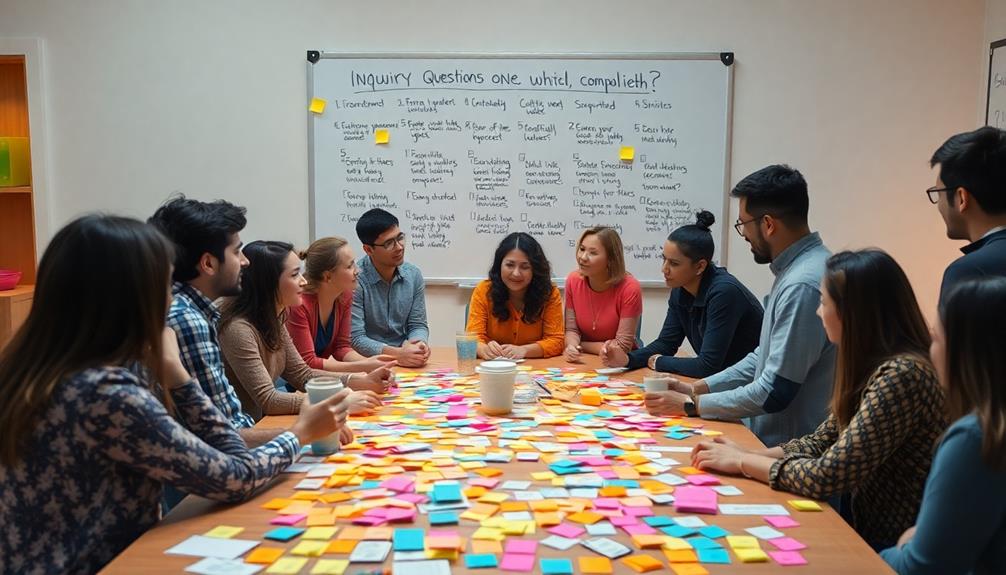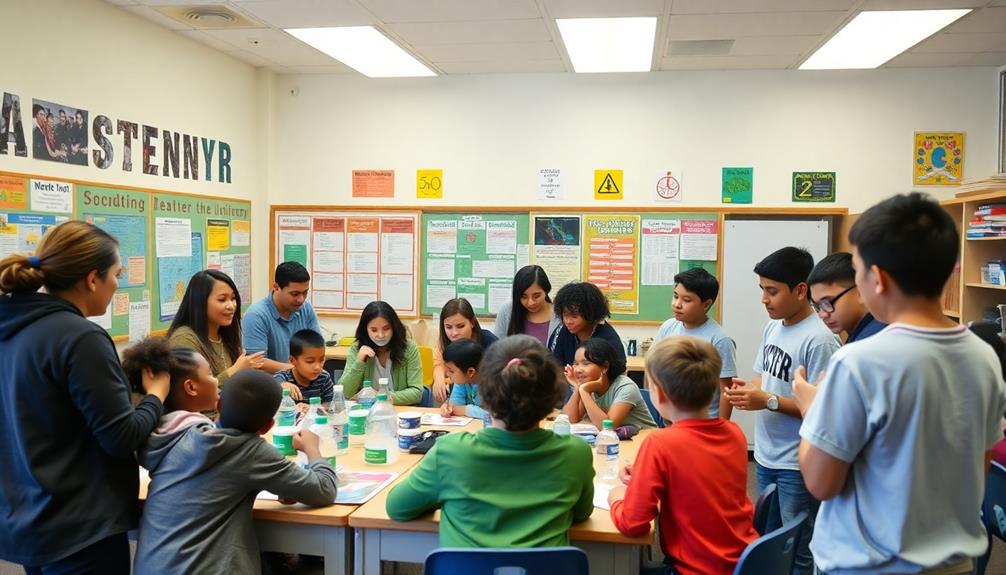Curious Mind
Curiosity-Driven Success: Stories From Innovators
Harness the power of curiosity through inspiring stories of innovators, and discover how their questions led to groundbreaking success. What will you uncover?

Curiosity drives innovation and success in remarkable ways. Think about how Thomas Edison and Alexander Fleming achieved extraordinary breakthroughs by asking questions and exploring new ideas. Companies like Google harness this power by allowing employees to spend 20% of their time on personal projects, resulting in innovations like Gmail. Tesla revolutionized automotive design through curiosity-driven thinking, proving that asking "what if" can lead to game-changing ideas. Embracing curiosity can transform your approach to problem-solving and creativity. By exploring how innovators use this mindset, you'll uncover valuable lessons for your own journey.
Key Takeaways
- Curiosity fosters innovation, leading to breakthroughs like antibiotics and the internet, transforming industries and improving lives.
- Google's 20% time initiative exemplifies how allocating time for personal projects can yield successful products and enhance employee performance.
- Tesla's innovative design thinking and sustainable practices have redefined the automotive industry, showcasing the impact of curiosity-driven approaches.
- NASA's Curiosity rover demonstrates engineering excellence, utilizing advanced technology to explore Mars and enhance our understanding of the planet.
- Mentorship programs cultivate talent and drive innovation by enhancing diverse perspectives and fostering collaboration among aspiring leaders.
The Power of Curiosity

Curiosity is like a spark that ignites innovation and drives progress. When you embrace curiosity, you open yourself up to new possibilities and solutions. Think about how figures like Thomas Edison and Alexander Fleming harnessed their inquisitive nature to create groundbreaking inventions like the light bulb and antibiotics. Their stories remind you that curiosity fuels not just individual achievement but also collective progress.
By understanding navigating small mistakes in your journey, you can transform setbacks into opportunities for growth.
In the workplace, fostering a culture of curiosity can dramatically enhance employee engagement. Research shows that organizations prioritizing curiosity see a 47% boost in employee performance. If you encourage questions and exploration, you create an environment where innovative ideas thrive.
Just look at Google's 20% time initiative, which birthed successful products like Gmail and Google News.
Curiosity isn't just limited to adults; children possess an innate curiosity that peaks at age five. By nurturing this trait, you can cultivate innovative thinkers.
Furthermore, in fields like data science, professionals often spend extra hours tinkering with data driven by their curiosity, leading to groundbreaking insights.
Historical Innovations That Inspire

Throughout history, groundbreaking innovations have shaped our world and inspired countless individuals. Imagine the impact of Johannes Gutenberg's printing press in 1440. It revolutionized knowledge dissemination, allowing people to explore new ideas that sparked the Renaissance and Reformation.
Fast forward to 1712, when James Watt improved the steam engine, fueling the Industrial Revolution. This innovation enhanced productivity in factories and transformed transportation.
The evolution of technology has continued, with advancements in AI capabilities driving efficiencies and new possibilities across various sectors.
Consider the significance of Alexander Fleming's discovery of antibiotics in 1928. This breakthrough drastically reduced mortality rates from bacterial infections, paving the way for the healthcare we rely on today.
The 1960s brought the development of the internet, initially ARPANET, which connected research institutions and evolved into a global communication network. This innovation changed how we exchange information and conduct business.
Technological Advancements and Impact

Innovations like the printing press and the internet have laid the groundwork for a rapidly changing technological landscape. The printing press, invented by Johannes Gutenberg in 1440, revolutionized information dissemination, boosting literacy and spreading ideas during the Renaissance.
Fast forward to 1947, and you encounter transistors, which miniaturized technology and set the stage for personal computers, transforming our interaction with technology and each other. Diversification strategy in technological investments has become essential as these advancements continue to reshape industries.
The launch of the internet in the 1960s, beginning with ARPANET, connected universities and eventually expanded into a global network, reshaping communication, commerce, and information sharing.
Today, smartphones, derived from personal computer technology, offer instant access to information and communication, boasting over 3.8 billion users worldwide as of 2021. This highlights the pervasive impact of these technological advancements on daily life.
Also, consider the discovery of antibiotics by Alexander Fleming in 1928, which marked a monumental leap in medicine, drastically lowering mortality rates from bacterial infections.
Each of these technological advancements hasn't only changed how you live but has also shaped society in profound ways, driving innovations that continue to evolve and inspire.
Curiosity in Creative Problem Solving

Often, the most remarkable solutions stem from a simple spark of curiosity. This intrinsic drive to explore fuels creative problem-solving and can lead to unexpected breakthroughs.
Take, for example, the invention of Post-it Notes, which emerged from a failed adhesive experiment. Or consider the Mars Rover Curiosity, which showcased innovative engineering with its sky-crane landing method, overcoming Mars' challenges.
Curiosity not only inspires individual inventions but also shapes organizational cultures. Google's 20% time initiative encourages employees to explore personal projects, resulting in successful products like Gmail and Google News.
Similarly, in data science, a curious approach helps professionals uncover hidden patterns that can lead to significant financial gains for their organizations.
Here are a few key benefits of curiosity in creative problem-solving:
- Encourages innovative thinking
- Facilitates unexpected discoveries
- Promotes a culture of exploration
- Drives technological advancements
Case Study: Tesla's Disruption

Curiosity drives not just individual inventions but also entire industries, as seen in Tesla's approach to electric vehicles. Founded by Elon Musk in 2003, Tesla utilized Design Thinking to redefine transportation. Their innovative mindset led to groundbreaking advancements, such as the Model S, which won the MotorTrend Car of the Year award in 2012, setting a new standard for electric vehicles.
Here's a quick overview of Tesla's impact:
| Year | Milestone | Impact |
|---|---|---|
| 2003 | Tesla founded | Initiation of electric vehicle revolution |
| 2012 | Model S launched | First electric vehicle to win MotorTrend award |
| 2012 | Supercharger network introduced | Fast charging in 30 minutes |
| 2020 | 1 million cars sold | Demonstrated consumer demand for sustainability |
| 2020 | Market cap over $800 billion | Most valuable car manufacturer |
Tesla's proprietary Supercharger network and features like Autopilot showcase their commitment to innovation. With ongoing software updates, Tesla continues to enhance safety and functionality, solidifying its position at the forefront of the automotive industry.
Engineering Innovations: Mars Rover Missions

Mars rover missions exemplify the power of engineering excellence in exploring the unknown. Innovative solutions have allowed NASA's rovers, particularly the Curiosity rover, to navigate the harsh Martian landscape and conduct groundbreaking scientific research.
Launched in 2011 and landing in 2012, Curiosity has traveled over 28 kilometers, analyzing soil and rock samples for signs of past life.
Here's how engineering ingenuity shines in these missions:
- Sky-crane landing system guarantees safe landings on challenging terrain.
- Advanced scientific instruments, like a drill and analytical lab, enable in-depth analysis of Martian geology.
- Communication relay system through the Mars Reconnaissance Orbiter facilitates real-time data transmission to Earth.
- Success of Curiosity paves the way for future missions, including Perseverance, which aims to collect samples for potential return to Earth.
These engineering innovations not only enhance our understanding of Mars but also inspire future explorations.
The lessons learned from the Curiosity mission highlight the importance of creativity and adaptability in solving complex challenges, setting the stage for further discoveries in our quest to understand the universe.
Cultivating Innovation at Google

At Google, innovation thrives through a unique blend of freedom and support. You can dedicate 20% of your work hours to personal projects, which has led to successful products like Gmail and Google News. This initiative empowers you to explore your passions while contributing to the company's goals.
Key to this innovative culture is psychological safety. You're encouraged to share ideas and feedback without fearing negative consequences, creating an environment where creativity flourishes.
With a focus on diverse, cross-functional teams, you'll collaborate with colleagues from various backgrounds, bringing together different perspectives to tackle complex challenges.
Google also invests in resources and tools that support your innovative efforts. You have access to advanced technologies and platforms for experimentation and prototyping, sparking your creativity and enabling you to bring ideas to life.
Additionally, failures are celebrated as learning opportunities, reinforcing a growth mindset. This approach encourages you to continuously improve and explore new ideas.
In this way, Google cultivates an atmosphere where curiosity drives success, allowing you to innovate and contribute meaningfully to the future of technology.
Collaborative Endeavors in Innovation

When you think about innovation, consider how interdisciplinary collaboration can spark new ideas and solutions.
With global communication networks at your fingertips, you can easily connect with experts from different fields.
Plus, mentorship plays an essential role in developing talent, ensuring that fresh perspectives keep flowing into the innovation process.
Interdisciplinary Collaboration Benefits
Interdisciplinary collaboration stands out as a powerful catalyst for innovation, driving teams to tackle complex challenges from multiple angles. When you bring together diverse expertise, you're likely to uncover groundbreaking solutions that wouldn't emerge in isolation.
For instance, NASA's Mars Rover missions exemplify how engineers and scientists collaborate to overcome intricate design and communication issues. Similarly, the development of CRISPR gene-editing technology highlights the transformative potential of merging biology, chemistry, and engineering perspectives.
Here are some key benefits of interdisciplinary collaboration:
- Enhanced Creativity: Diverse viewpoints spark innovative ideas and solutions.
- Improved Problem-Solving: Teams can approach challenges from various angles, leading to more effective outcomes.
- Broader Skill Sets: Collaborators contribute unique skills, enriching the project with varied expertise.
- Increased Agility: Flexibility in tackling problems allows teams to adapt quickly to new information or challenges.
Organizations like Google and SpaceX have leveraged interdisciplinary collaboration to foster creativity and drive success.
Global Communication Networks
Global communication networks have revolutionized the way innovators collaborate and share ideas, breaking down geographical barriers that once limited progress. The internet, originating from ARPANET in the 1960s, laid the groundwork for this transformation, connecting universities and evolving into a global platform for information exchange.
Through these networks, you can participate in collaborative efforts that have spurred significant innovations, such as open-source software projects. Platforms like GitHub illustrate how global communication facilitates teamwork among programmers, enabling you to share code and contribute to collective projects.
Additionally, social media has reshaped how innovators connect, allowing for instant communication and idea sharing across diverse communities. This accessibility fosters continuous learning, as you engage with experts and peers worldwide.
The interdisciplinary collaboration made possible by these global networks has led to breakthroughs like CRISPR gene editing, where shared research and insights from scientists around the globe have propelled advancements in biotechnology. By leveraging global communication networks, you're not just part of the conversation; you're actively shaping the future of innovation.
Mentorship and Talent Development
Mentorship is a powerful catalyst for talent development, transforming aspiring innovators into industry leaders. By participating in mentorship programs, you can connect with seasoned professionals who guide you through complex challenges, just like the initiatives at NASA and tech giants like Google and Microsoft.
These connections foster knowledge transfer and skill-building that are essential for your growth.
The benefits of mentorship extend beyond individual growth; they enhance organizational success as well. Consider these key points:
- Mentees are five times more likely to get promoted than those without mentors.
- Organizations with strong mentorship programs see a 30% higher retention rate among high-potential employees.
- Cross-functional teams, encouraged by mentorship, harness diverse perspectives to drive innovation.
- Collaborative endeavors in innovation often lead to successful projects.
As you engage in mentorship, remember that it's not just about learning; it's about collaboration and building a community of innovators.
Embrace the opportunity to learn from others and share your insights, as this reciprocal relationship can redefine your career trajectory in remarkable ways.
Ethical Considerations in Innovation

When you're pushing the boundaries of innovation, it's vital to balance progress with ethical considerations.
Unintended consequences can arise from new technologies, so you need a responsible development framework that prioritizes societal well-being.
Balancing Progress and Ethics
In today's fast-paced world of technological innovation, steering through the intersection of progress and ethics is more essential than ever.
As advancements in artificial intelligence (AI) surge forward, ethical concerns over job displacement and biases in decision-making processes arise. It's imperative to adopt responsible innovation practices to address these issues.
Consider these ethical considerations when innovating:
- Job Displacement: Assess how AI may impact employment opportunities and seek solutions to retrain workers.
- Bias Mitigation: Guarantee AI systems are designed to minimize biases that could lead to unfair outcomes.
- Data Privacy: Prioritize user rights and transparency in data handling to build trust in new technologies.
- Societal Values: Balance scientific progress, like CRISPR gene editing, with ethical boundaries that reflect societal norms.
Unintended Consequences of Innovation
As you navigate the complexities of innovation, it's important to recognize that every breakthrough can bring unforeseen challenges. The introduction of antibiotics, for instance, revolutionized medicine but also led to the unintended consequences of antibiotic-resistant bacteria, creating a significant public health threat.
Similarly, the rapid advancement of artificial intelligence raises ethical dilemmas regarding privacy, bias, and job displacement, emphasizing the need for vigilance in development.
Consider social media: while it's transformed communication, it has also fueled misinformation, worsened mental health issues, and increased societal polarization.
The shift to electric vehicles aims to cut carbon emissions, yet the mining of lithium and cobalt for batteries raises ethical questions about environmental impact and labor practices.
Genetic editing technologies like CRISPR promise to cure diseases, but they also introduce ethical concerns about "designer babies" and unintended genetic consequences that could reverberate through generations.
As you innovate, remember that the unintended consequences of your work may not only challenge your initial goals but also impact society in ways you can't immediately foresee. Staying aware of these complexities is essential for responsible and ethical innovation.
Responsible Development Frameworks
Responsible development frameworks are essential for guaranteeing that innovations not only advance technology but also uphold ethical standards that benefit society.
As you engage with new technologies, consider the importance of integrating ethical guidelines into your design and implementation processes. The rapid evolution of artificial intelligence, for example, raises significant ethical questions about safety, privacy, and biases. Without responsible development frameworks, these issues can lead to harmful consequences.
To foster responsible innovation, remember to focus on:
- Human well-being: Prioritize the impact of technology on individuals and communities.
- Historical lessons: Learn from past innovations to mitigate risks associated with new developments.
- Stakeholder collaboration: Involve ethicists, technologists, and community representatives in the framework development process.
- Continuous reflection: Regularly assess the ethical implications of your discoveries to guarantee accountability.
Fostering a Culture of Curiosity

Fostering a culture of curiosity transforms workplaces into hubs of innovation and creativity. When organizations allow employees to dedicate time to personal projects, like Google's 20% time policy, it sparks exploration and growth.
Encouraging questioning and experimentation, as seen in Tesla's iterative design processes, leads to remarkable advancements in technology and product development.
To truly thrive, companies need to prioritize psychological safety. When employees feel free to share ideas without fear of judgment, collaborative innovation flourishes, as demonstrated by Pixar's practices.
Celebrating failures as learning opportunities creates a resilient mindset, essential for continuous improvement and innovation.
Additionally, forming cross-functional teams that bring together diverse perspectives can drive innovative solutions. This approach, evident in successful tech startups, fosters creativity and enhances problem-solving capabilities.
By actively engaging in these practices, you'll contribute to fostering a culture of curiosity that not only inspires individual growth but also propels the entire organization forward.
Embracing curiosity isn't just a strategy; it's a necessary mindset for maneuvering the complexities of today's fast-paced world.
Frequently Asked Questions
What Is an Example of Curiosity Driven Research?
An example of curiosity-driven research is Alexander Fleming's discovery of penicillin.
When he noticed mold inhibiting bacterial growth in his lab, he didn't dismiss it; instead, he investigated further. This curiosity led to the development of the first antibiotic, revolutionizing modern medicine.
What Inventions Are Based on Curiosity?
Curiosity's like a spark that ignites innovation. Many inventions stem from this curious nature.
For instance, the Post-it Note emerged when Spencer Silver's weak adhesive caught Art Fry's attention. Similarly, the Tesla Roadster was born from Elon Musk's desire to explore electric vehicles.
Then there's Superglue, discovered by Harry Coover during material experiments. Each of these inventions showcases how a simple question or unexpected moment can lead to groundbreaking creations.
What Is Curiosity as an Innovator?
Curiosity as an innovator means you're constantly questioning and exploring new ideas.
You challenge existing norms and seek out answers to improve processes or create something entirely new. This mindset helps you embrace failure, viewing it as a stepping stone rather than a setback.
Does Curiosity Lead to Success?
Imagine a seed planted in fertile soil; with curiosity as water, it blooms into a vibrant flower. Curiosity absolutely leads to success.
When you embrace it, you challenge norms and explore new possibilities. Research shows that curious individuals excel in problem-solving, enhancing job performance and driving innovation.
By fostering your curiosity, you not only adapt but thrive, paving your path to career advancement and meaningful contributions in your field.
Conclusion
Curiosity is the spark that ignites the flame of innovation, fueling your journey toward groundbreaking ideas. Just as a compass guides a sailor through uncharted waters, embracing curiosity leads you to unimagined possibilities. By nurturing this inquisitive spirit and collaborating with others, you can transform challenges into stepping stones. So, immerse yourself in the ocean of questions, let your imagination soar, and watch as the fruits of your curiosity bloom into a garden of success.
Curious Mind
Curious Minds Unite: Building Communities Around Inquiry
Maximize your potential by discovering how to create a community that thrives on inquiry and exploration—what transformative journey awaits you?

Curiosity drives your learning, and building a community around inquiry helps you tackle complex questions together. By engaging in real-world challenges, you'll foster collaboration and critical thinking within this supportive environment. Start by crafting open-ended inquiry questions that ignite your interests. Implement engaging lessons that promote exploration and reflection. Involve community resources and local experts to enrich your investigations. Presenting your findings to peers can boost confidence while enhancing your social skills. As you explore these strategies, you'll find more ways to cultivate a vibrant space for shared curiosity and personal growth.
Key Takeaways
- Foster collaboration by connecting students with local experts to address community issues through inquiry-based projects.
- Utilize community resources like libraries and museums to enhance research opportunities and enrich student learning experiences.
- Encourage civic engagement by forming partnerships that allow students to explore real-world problems and develop actionable solutions.
- Promote critical thinking by brainstorming relevant topics for inquiry that resonate with students' interests and community needs.
- Create a supportive learning environment that values exploration and encourages students to share their findings with peers and the community.
Understanding Inquiry Principles

Inquiry is a powerful approach that sparks your curiosity and engages you in problem-solving. As you immerse yourself in the inquiry process, you'll find that it starts with a question that ignites your interest, leading to an investigation that builds knowledge.
By framing significant and inquiry questions, you create a structure that promotes student-directed learning and fosters collaboration among peers. Engaging in inquiry also aligns with the principles of emotional regulation, as maneuvering complex questions helps you manage your feelings and responses to challenges, enhancing your overall learning experience.
This process requires a supportive environment, akin to how caregivers influence emotional development by fostering trust and facilitating exploration.
When you focus on real-world problems, your inquiry questions gain relevance, making your engagement more meaningful. This emphasis on informed action encourages you to think critically and apply what you learn to actual situations.
Remember, your teacher's role isn't to dictate the learning journey but to facilitate it, allowing you the freedom to explore and discover.
Moreover, it's vital to view grades as a reflection of your learning outcomes rather than the primary focus of the inquiry process. This perspective encourages deeper engagement with the material, enhancing your understanding and retention.
Crafting Inquiry Questions

When you craft inquiry questions, think about how they can spark your students' curiosity and lead to deeper exploration.
Consider integrating themes from end-of-life planning to encourage discussions about important life decisions. Aim for open-ended questions that invite discussion and investigation, rather than just yes or no answers.
Engaging Student Curiosity
Curiosity is a powerful tool in the classroom, driving students to explore and engage deeply with their learning. To harness this curiosity, you need to craft complex, open-ended inquiry questions that ignite sustained investigation. These questions should be simple enough for students to grasp, while still connecting to Essential Questions and broader learning objectives.
Essential Questions play a vital role, framing your unit structure and sparking genuine interest among students. They need to be compelling, encouraging meaningful engagement and a deeper exploration into the subject matter.
When students direct their learning, they're more likely to collaborate and take ownership of their inquiries, which greatly enhances their engagement and investment.
Additionally, incorporating a call to action in your inquiry questions can make learning feel relevant and urgent. By connecting investigations to real-world issues, you foster a sense of purpose among students, making learning more impactful.
Ultimately, by focusing on engaging student curiosity through well-crafted inquiry questions, you create an environment where students are excited to learn, investigate, and discover.
Open-Ended Inquiry Framework
Building on the excitement generated by engaging student curiosity, crafting effective inquiry questions is key for sustaining that interest. To kick off an inquiry project, you'll want to design questions that are complex, open-ended, and compelling. This approach ignites curiosity and drives deeper investigations.
Incorporating strategies for improvement, such as setting clear goals, can enhance the quality of inquiry questions. Additionally, fostering a supportive environment where students feel comfortable sharing their thoughts aligns with top wellness tips for creating a healthy learning atmosphere. Keep your questions simple enough for students to understand and share, ensuring they feel accessible and engaging.
A successful inquiry question should include a call to action, urging students to think beyond the classroom. Encourage them to reflect on the future implications of their inquiries. Essential questions help structure sustained investigations by connecting to broader inquiry questions and aligning with educational standards.
When drafting your inquiry questions, group objectives into content sections to enhance organization and clarity. This strategy promotes a more focused inquiry process and helps students navigate the complexities of their investigations.
Designing Engaging Lessons

Engaging lessons are the backbone of effective teaching, and they thrive on a structured approach that captivates students' interest. To create memorable learning experiences, you can break your lessons into three essential parts: Opening, Active Inquiry, and Closing. Each segment connects students' curiosity to essential questions and real-world issues.
| Lesson Component | Purpose |
|---|---|
| Opening | Introduces the topic and sparks curiosity. |
| Active Inquiry | Encourages exploration, investigation, and collaboration. |
| Closing | Facilitates reflection and reinforces understanding. |
In the Active Inquiry phase, students dive deeply into topics, taking ownership of their learning while collaborating with peers. This not only fosters a sense of community but also promotes critical thinking. Incorporating real-world problems makes the content relevant, further motivating students to engage meaningfully.
Evaluating Research Sources

Quality research sources act as the foundation for meaningful inquiry, guiding students through complex topics with accuracy and relevance. When you're evaluating research sources, it's vital to assess their accuracy, relevance, and potential biases. This process helps you determine which materials will truly enrich your understanding of a subject.
Start by defining the purpose of your source searches. This clarity will lead you toward appropriate materials that align with your inquiry questions.
Next, consider the diversity of the sources. Engaging with a variety of perspectives not only broadens your knowledge but also fosters critical thinking.
Training yourself to critically evaluate educational materials is essential in today's complex media landscape. Use established evaluation protocols to dissect sources methodically.
Ask yourself if the information is credible, whether the authors have relevant expertise, and if there's any noticeable bias present.
Community-Based Inquiry Strategies

Community-based inquiry strategies bring learning to life by connecting students with local resources and real-world issues. By engaging with their communities, you help students create a more relevant and meaningful learning experience. Utilizing local experts and organizations adds authenticity to project-based learning, making investigations feel more impactful.
Here's a simple framework to guide your approach:
| Step | Action | Outcome |
|---|---|---|
| 1. Identify Issues | Observe community challenges | Relevant inquiry questions |
| 2. Engage Experts | Connect with local professionals | Authentic insights |
| 3. Guide Questions | Start with personal, relatable queries | Deeper engagement |
| 4. Organize Topics | Use a Community Questions Organizer | Generate meaningful inquiries |
Encouraging students to observe their surroundings and formulate inquiry questions fosters critical thinking and a sense of agency in their learning. When you implement community-based inquiry strategies, you're not just teaching; you're empowering students to become active participants in their education and community.
Planning Effective Projects

When planning effective projects, you need to set clear objectives that guide your students' learning.
Engaging community resources can enhance the project and create real-world connections.
Fostering collaborative learning helps students work together, encouraging deeper understanding and shared inquiry.
Setting Clear Objectives
Setting clear objectives is essential for planning effective projects, as it directs both educators and students toward desired outcomes. When you establish specific goals, you align your project with educational standards and student needs. Using planning templates and web maps can help you organize these objectives, vocabulary, and materials, providing a structured approach to inquiry-based learning.
| Objectives | Strategies |
|---|---|
| Define desired outcomes | Utilize KWL charts for student interests |
| Outline roles for teachers/students | Promote accountability and focus |
| Schedule reflection checkpoints | Adjust goals based on progress |
| Guarantee relevance to learners | Incorporate exploratory play |
Incorporating student interests makes objectives more meaningful, enhancing engagement. Establishing clear roles during exploration phases also promotes accountability. Regular reflection and assessment checkpoints allow you to gauge progress, fostering a growth mindset among students. By setting clear objectives, you create a roadmap to success, guaranteeing your projects are both effective and enriching for everyone involved.
Engaging Community Resources
Engaging community resources can greatly enhance the effectiveness of project-based learning (PBL) by connecting students with real-world issues and local stakeholders. When you incorporate local experts and community members as collaborators, you provide students with valuable insights that deepen their understanding of inquiry topics. This authentic connection makes learning more relevant and impactful.
Utilizing community assets like libraries, museums, and local organizations can enrich your students' research opportunities and broaden their investigations. By planning effective projects that brainstorm relevant community topics, you encourage students to think critically about their surroundings. Tools like a Community Questions Organizer can guide them in formulating inquiry questions based on local contexts, making the learning process more engaging.
Establishing partnerships with community resources not only enhances project outcomes but also promotes civic engagement and responsibility among students. They'll learn to apply their skills in meaningful ways, fostering a sense of belonging and connection to their community.
Ultimately, engaging community resources in PBL transforms classroom learning into a vibrant exploration of the world around them, paving the way for informed, active citizens.
Fostering Collaborative Learning
A well-structured project plan is essential for fostering collaborative learning in any classroom. Start by identifying your students' interests through exploratory activities and KWL charts. These tools help assess their existing knowledge and misconceptions, guiding you in formulating effective inquiry questions.
Next, utilize inquiry plans that clearly outline objectives, vocabulary, and materials. Incorporating web maps will enhance clarity and focus, allowing students to visualize their inquiry directions.
You can also establish various learning stations within your initial project-based learning (PBL) projects. This approach promotes differentiated instruction and deeper engagement across multiple subjects.
As students begin their collaborative projects, encourage them to document their observations through hands-on experiences. Organize their data using formats like wonder charts and web maps to facilitate collaboration and a collective understanding.
Presenting Student Work

When students present their work, they not only showcase their learning but also build confidence and enhance their speaking skills. Presenting student work in a showcase format allows them to share their insights with peers, parents, and the wider community, fostering a sense of accomplishment.
Diverse formats like live demonstrations, videos, and gallery walks engage the audience and create a meaningful context for their projects. This presentation phase acts as a culmination of their inquiry, where students can creatively express their understanding through projects such as maps, murals, and big books.
It's crucial to encourage students to embrace the opportunity to present, as it adds depth to their educational experiences. Involving parents and the community enriches these presentations, strengthening the connection between schools and families.
Furthermore, opportunities for peer feedback during the presentations help students develop critical thinking and collaboration skills, which are essential for success in the 21st-century workplace.
Fostering Curiosity in Education

Fostering curiosity in education is essential for engaging students and enhancing their learning experiences.
By employing inquiry-based learning strategies, you can spark their interest and encourage collaboration within the community.
This approach not only drives student exploration but also strengthens connections between families and educational institutions.
Importance of Inquiry-Based Learning
Inquiry-based learning (IBL) transforms the educational landscape by igniting students' natural curiosity and encouraging them to explore open-ended questions. When you engage in IBL, you develop a mindset that enhances critical thinking and problem-solving skills essential for real-world applications.
Research shows that IBL promotes a deeper understanding of subject matter, allowing you to retain information longer and engage more actively compared to traditional learning methods.
By directing your own inquiries, IBL cultivates a sense of ownership over your learning journey, which boosts motivation and participation. This autonomy makes the educational experience more meaningful and relevant.
Engaging in inquiry-based projects connects what you learn in the classroom to real-world issues, preparing you to become an informed and active citizen ready to tackle global challenges.
Moreover, the collaborative nature of IBL enhances your social skills and teamwork abilities. Working with peers to investigate topics, share findings, and present knowledge builds a supportive learning community that enriches the educational experience.
Ultimately, the importance of inquiry-based learning lies in its ability to foster curiosity, engagement, and a deeper understanding of the world around you.
Strategies to Spark Curiosity
Curiosity is a powerful catalyst for learning, and sparking it in educational settings can lead to profound engagement. To foster curiosity, start by using complex, open-ended inquiry questions that ignite your students' interests. This approach encourages inquiring minds to explore deeper and drive sustained investigations.
Implementing student-directed learning is another effective strategy. By allowing learners to take charge of their inquiries, you empower them to collaborate with peers and tackle real-world problems, leading to meaningful engagement. In inquiry-based environments, you'll notice a boost in critical thinking and creativity as students explore their passions while developing informed citizenship skills.
Additionally, provide diverse sources and community resources to enhance the learning experience. Connecting inquiries to broader societal issues helps students gain different perspectives and understand the relevance of their work.
Regular reflection and feedback during inquiry projects will cultivate a culture of curiosity. This practice allows students to appreciate their learning journeys, inspiring them towards lifelong learning.
Community Engagement and Collaboration
Engaging with your community can greatly enhance the learning experience for students by connecting them with local resources and real-world issues. Community engagement fosters curiosity, turning classrooms into vibrant hubs of inquiry-based learning.
When students collaborate on projects that involve families and community members, they feel empowered to explore their interests while building a supportive environment.
Utilizing community-based inquiry, like podcasts or local observation, sparks relevant questions, helping students deepen their understanding of their surroundings. This hands-on approach makes learning more meaningful.
Plus, involving authentic community audiences in project presentations not only enhances the relevance of student work but also cultivates a sense of purpose and connection to their education.
Educators play a significant role in this process. By sharing resources and best practices through networking and mentorship, they create a collaborative atmosphere that encourages curiosity and innovation.
When you foster community engagement in your educational practices, you're not just teaching; you're building a network of inquiry that enriches students' experiences and prepares them for the world beyond the classroom.
Embrace these opportunities, and watch your students' curiosity flourish!
Innovations in Inquiry Learning

Innovative approaches to inquiry learning are reshaping the educational landscape by emphasizing student-driven exploration. In social studies, this means you can plunge into real-world problems, fostering critical thinking and creativity through collaborative projects. By engaging with relevant issues, you'll find that learning becomes more meaningful and applicable to your life.
The integration of multimedia resources enhances your motivation and makes lessons more dynamic. Imagine using videos, podcasts, or interactive maps to explore historical events or current events—this approach not only grabs your interest but also enriches your understanding.
Effective inquiry learning relies on diverse and high-quality sources, enabling you to gather, evaluate, and synthesize information critically, which is essential for developing informed perspectives.
Implementing inquiry learning frameworks allows your educators to adapt their teaching strategies based on your needs and interests. This flexibility creates an environment where you feel empowered to pursue topics that intrigue you, leading to a deeper understanding of complex social studies concepts.
Ultimately, these innovations foster a community of curious learners, ready to engage with the world around them and contribute thoughtfully to discussions about society and culture.
Supporting Educators and Students

In a classroom thriving on inquiry-based learning, educators play a pivotal role in guiding students through their explorations. Instead of dictating the learning process, you facilitate, fostering a collaborative environment that encourages curiosity.
To effectively support this shift, professional development sessions and mentorship opportunities are vital for new educators. They provide the necessary guidance to implement inquiry-based strategies and share valuable resources.
Utilizing diverse resources, like community involvement and multimedia projects, enhances student engagement. When students usually connect their learning to real-world issues, their motivation skyrockets.
You can also employ planning templates and web organizers to outline objectives and materials, guaranteeing structured inquiry while allowing flexibility for students to explore their interests.
Creating a supportive community among educators is essential. By sharing best practices and resources, you enrich the educational experiences for both yourself and your students.
This collaborative spirit not only empowers teachers but also guarantees that students usually benefit from a rich tapestry of knowledge and skills. Together, you can cultivate an inquiry-driven classroom that inspires students to explore, question, and discover the world around them.
Frequently Asked Questions
What Are the 5 Guiding Questions of Inquiry?
The five guiding questions of inquiry are essential for your learning journey. First, ask yourself, "What do I want to learn?"
Next, consider, "Why is this important?"
Then, think about, "How will I find the information?"
After gathering data, reflect on, "What did I learn?"
Finally, determine, "How can I share my learning with others?"
These questions help you stay focused, encourage collaboration, and deepen your understanding of the topics you explore.
What Is an Example of a Unit of Inquiry?
Imagine a unit of inquiry so engaging it could spark a wildfire of curiosity! For example, you might explore "What makes a community thrive?"
You'll investigate local resources, interview community leaders, and analyze data on social services. Throughout this journey, you'll connect with peers, present your findings, and reflect on your insights.
This hands-on approach not only enhances your understanding but also cultivates a deeper appreciation for the dynamics of your community.
What Does Inquiry Look Like in Kindergarten?
Inquiry in kindergarten looks vibrant and engaging.
You'll see kids exploring their environment, asking questions, and working together in small groups. They might go on nature walks, jotting down their observations, or using KWL charts to share what they know and want to learn.
Through hands-on activities and presentations, they build confidence and communication skills.
How to Create an Inquiry Project?
To create an inquiry project, start by picking a guiding question that resonates with your students.
Use planning templates to define your objectives and materials. Incorporate hands-on activities and learning stations where students can explore and document their findings.
Encourage them to present their discoveries in engaging formats, like demonstrations or videos.
Conclusion
In a world where curiosity can spark innovation, building communities around inquiry transforms mere questions into powerful explorations. While traditional classrooms may stifle creativity, embracing inquiry fosters vibrant discussions, igniting a passion for learning. You're not just teaching facts; you're cultivating thinkers who challenge the status quo. As you support educators and students alike, you create a rich tapestry of ideas and discoveries, where every question leads to new horizons and every answer opens a door to further inquiry.
Curious Mind
Why Every Leader Should Cultivate Their Inner Curiosity
Transforming your leadership style through curiosity can unlock innovation and team potential, but how do you begin this crucial journey?

Every leader should cultivate their inner curiosity because it drives innovation and enhances team dynamics. When you ask open-ended questions, you foster a culture of continuous learning, which boosts employee engagement and trust. Curiosity helps you adapt to changes and encourages a creative problem-solving environment. It also promotes collaboration, allowing team members to leverage their unique strengths. By embracing curiosity, you not only improve organizational performance but also prepare future leaders. If you're ready to explore how to ignite this curiosity in your leadership style, there's much more to uncover.
Key Takeaways
- Cultivating curiosity fosters innovation, enabling leaders to explore unconventional ideas and improve problem-solving capabilities.
- Curious leaders enhance team dynamics by promoting open communication and collaboration, leading to better decision-making.
- A culture of curiosity increases employee engagement, resulting in higher morale and retention rates within the organization.
- Curiosity drives continuous learning and adaptation, equipping leaders to navigate complexities and identify growth opportunities.
- Embracing curiosity builds trust among team members, creating a safe environment for sharing insights and encouraging creativity.
The Power of Curiosity in Leadership

Curiosity fuels effective leadership, driving innovation and creative problem-solving. When you embrace curiosity as a leader, you encourage your team to explore unconventional ideas and challenge the status quo. This open-minded approach fosters a culture of continuous learning, which not only enhances employee engagement but also boosts productivity and retention within your organization.
By promoting the benefits of curiosity, you enable your team to adapt and thrive in an ever-changing environment.
By posing engaging questions, you deepen understanding and insights, enhancing collaboration and communication among team members. Your curious mindset helps you adapt to industry changes, identify customer needs, and explore new market opportunities—key factors for sustainable growth.
Curiosity strengthens relationships too. When you actively listen and engage in open dialogue, you build trust and rapport, enhancing teamwork and collaboration across diverse teams. This dynamic fosters an environment where everyone feels valued and empowered to share their ideas.
In essence, cultivating curiosity as a leader isn't just about asking questions; it's about creating a space where exploration and innovation thrive. So, embrace your inner curiosity and watch as it transforms not only your leadership style but also the entire culture of your organization.
Curiosity Fuels Innovation and Creativity

A thriving culture of inquiry can greatly boost innovation and creativity within your organization. When curiosity thrives, it encourages you and your team to explore unconventional ideas, leading to unique solutions that enhance productivity. Research shows that organizations with curious leadership achieve 28% higher innovation scores, emphasizing the link between curiosity and creative problem-solving.
By engaging in inquiry-based dialogue, you can uncover and leverage collective strengths, resulting in better decisions and innovative outcomes. Curious leaders are 50% more likely to implement innovative practices, showcasing the critical role curiosity plays in driving growth.
Here's a quick look at how curiosity fuels innovation:
| Aspect | Curiosity Thrives | Impact on Innovation |
|---|---|---|
| Leadership Engagement | Encourages exploration of ideas | Unique solutions emerge |
| Team Collaboration | Leverages diverse perspectives | Enhanced decision-making |
| Resilience to Challenges | Fosters experimentation | Creative solutions flourish |
| Creative Thinking Environment | Promotes open dialogue | Ideas are freely shared |
| Implementation of Innovations | Drives continuous improvement | Growth and success are achieved |
Embracing curiosity not only fosters a creative atmosphere but also propels your organization toward innovative heights.
Enhancing Team Dynamics Through Curiosity

Curiosity can transform your team's dynamics by fostering open communication and trust.
When you encourage collaborative problem-solving, your team members feel empowered to share their ideas and perspectives.
This creates an environment where everyone works together more effectively, leading to stronger relationships and better results.
Fostering Open Communication
Effective communication is the cornerstone of any successful team, and fostering it through curiosity can greatly enhance team dynamics. When you cultivate curiosity within your leadership style, you create a safe space where team members feel comfortable sharing their thoughts. This openness leads to higher engagement and collaboration levels, vital for a thriving team environment.
Additionally, clearing brain fog through proper nutrition can help enhance cognitive function, which contributes to more effective communication.
By employing inquiry-based approaches, you encourage diverse ideas and perspectives that enrich the decision-making process. Regularly asking open-ended questions not only promotes deeper understanding among team members but also strengthens relationships and builds trust within the group.
This trust is essential, as teams led by curious leaders tend to be more resilient in the face of challenges.
Curiosity encourages exploration of multiple solutions, allowing team members to learn from each other's insights. It fosters a culture of continuous learning, where everyone feels valued and empowered to contribute.
As a result, you'll notice improved performance and innovation within your team. By prioritizing open communication through curiosity, you can cultivate a dynamic environment that drives success and fosters stronger connections among your team members.
Encouraging Collaborative Problem-Solving
Building on the foundation of open communication, encouraging collaborative problem-solving takes your team's dynamics to the next level.
As a leader, your curiosity can create an environment where team members feel safe to share diverse ideas and perspectives. This openness leads to innovative solutions that enhance overall performance. Engaging in inquiry-based discussions allows you to explore multiple angles of challenges, which results in more informed decision-making and a stronger sense of ownership over outcomes.
By fostering a culture of curiosity within your team, you also promote resilience and adaptability in addressing obstacles.
Research shows that teams led by curious leaders exhibit higher engagement levels, correlating with increased productivity and commitment to shared goals. By promoting curiosity, you can identify and leverage the unique strengths of each team member, ensuring that all voices contribute meaningfully to the problem-solving process.
Cultivating a culture of curiosity within your team not only builds resilience in the face of challenges but also fosters unity.
When members support each other in exploring complex issues, they develop a collaborative spirit that can tackle any obstacle. By encouraging curiosity, you empower your team to navigate difficulties together, leading to stronger connections and enhanced problem-solving capabilities.
Building Trust and Rapport
Trust and rapport form the backbone of a high-performing team, and fostering these elements often starts with a leader's genuine curiosity. When you actively engage with your team members through open-ended questions, you're not just gathering information; you're building trust. This approach creates a culture of communication and understanding that enhances relational bonds.
By showing real interest in your team's perspectives, you encourage collaboration and nurture a more cohesive work environment. Research indicates that teams led by curious leaders see higher levels of employee engagement, which leads to improved productivity and retention rates. Your ability to actively listen allows you to uncover underlying issues and motivations, enabling you to provide tailored support that strengthens relationships.
Establishing a culture of inquiry not only boosts team dynamics but also fosters psychological safety. When team members feel valued and empowered to share their ideas without fear of judgment, you're reinforcing trust and rapport.
In this supportive atmosphere, creativity thrives, and collective problem-solving becomes the norm. Embrace your curiosity to cultivate an environment where trust and rapport flourish, setting the stage for a truly high-performing team.
Building Trust and Open Communication

In the domain of leadership, fostering an environment where open communication thrives is essential for cultivating trust. When you actively demonstrate curiosity by asking questions, you create a space where your team feels safe to share their thoughts and ideas. This open dialogue signals that their perspectives are valued, enhancing collaboration and innovation.
Research shows that teams with leaders who engage in active listening report higher levels of psychological safety. This leads to stronger relationships and respect among team members. By modeling curiosity, you're not just gathering information; you're building rapport and creating a culture where everyone feels engaged and heard.
Moreover, organizations led by curious leaders often experience lower turnover rates. Employees are more likely to stay when they feel valued in an atmosphere that prioritizes open communication. When you ask questions and genuinely listen to the answers, you foster trust and encourage your team to share their insights freely.
In essence, cultivating curiosity can transform your leadership approach, allowing you to build a foundation of trust that enhances overall team dynamics.
Curiosity as a Tool for Growth

Curiosity serves as a powerful catalyst for growth, enabling leaders to navigate the complexities of today's rapidly evolving landscapes. When you embrace curiosity, you drive continuous learning and adaptation, essential for staying relevant in fast-changing industries.
By asking questions and exploring new ideas, you can identify unique opportunities and innovative solutions that contribute to sustainable organizational growth.
Research shows that teams led by curious leaders experience higher engagement levels, which translates to improved performance and productivity. Your curiosity fosters a culture of experimentation, where failures are seen as stepping stones to success.
This mindset enhances creativity within your team and encourages them to take calculated risks.
Moreover, by modeling curiosity, you create an environment that champions open communication and collaboration. This leads to stronger relationships and team cohesion, making it easier to tackle challenges together.
Your curiosity not only benefits you but also inspires those around you to explore new possibilities. So, cultivate your inner curiosity—it's not just a tool for your growth, but a means to elevate your entire team's potential.
Embrace it, and watch how it transforms your leadership journey.
Fostering Resilience in Teams

Resilience in teams thrives when leaders cultivate an environment where curiosity flourishes. When you, as a leader, embrace curiosity, your team is more likely to adapt effectively to challenges and changes. By promoting open communication, team members feel safe to express concerns and work together to find solutions during tough times.
Here's how fostering curiosity can enhance resilience:
| Curiosity Benefits | Impact on Resilience |
|---|---|
| Encourages open dialogue | Builds trust and collaboration |
| Promotes exploration of strategies | Enables teams to maneuver setbacks |
| Empowers growth mindset | Turns challenges into opportunities |
| Increases employee engagement | Boosts morale during adversities |
| Drives innovative solutions | Sustains performance over time |
A curious mindset allows your team to view obstacles as chances to grow, leading to creative solutions and improved outcomes. By nurturing curiosity, you not only enhance team resilience but also create a culture where everyone feels valued and motivated to contribute. Cultivating this environment is essential for maneuvering the complexities of today's work landscape.
Developing Future Leaders With Curiosity

To develop future leaders, you need to mentor them through inquiry and encourage them to embrace uncertainty.
By fostering a culture of curiosity, you help them ask the right questions and explore new ideas together.
This not only strengthens their leadership skills but also builds collaborative relationships within their teams.
Mentoring Through Inquiry
Mentoring through inquiry transforms the way future leaders approach challenges and opportunities. By fostering a culture of curiosity, you empower your mentees to ask questions that challenge assumptions and explore diverse perspectives. This process not only develops critical thinking skills but also nurtures a growth mindset, encouraging emerging leaders to see challenges as learning opportunities rather than obstacles.
Through inquiry-based mentoring, you model the importance of curiosity, enabling your mentees to navigate the complexities of modern organizations. This approach cultivates adaptability and teamwork, essential traits for future leaders. Research shows that organizations embracing curiosity-driven leadership development enjoy higher employee engagement and innovation, positively affecting overall performance.
Here's a quick look at the benefits of mentoring through inquiry:
| Benefit | Description | Impact on Leadership |
|---|---|---|
| Critical Thinking Development | Encourages questioning assumptions | Improved decision-making skills |
| Growth Mindset | Views challenges as learning opportunities | Fosters resilience and adaptability |
| Empowerment | Models curiosity for mentees | Enhances team collaboration |
| Organizational Performance | Boosts engagement and innovation | Drives overall success |
Embrace mentoring through inquiry to cultivate the leaders of tomorrow.
Embracing Uncertainty Together
In a world where change is constant, embracing uncertainty becomes essential for developing future leaders. By cultivating curiosity, you equip yourself and others with the skills to navigate complexity and ambiguity. This adaptability is vital in today's fast-paced work environment.
Leadership development programs that prioritize curiosity foster critical thinking and strategic mindsets, allowing you to tackle modern challenges effectively.
When you encourage future leaders to ask questions and explore new ideas, you help them develop a growth mindset. They'll begin to see challenges not as obstacles but as opportunities for learning and innovation.
As a curious leader, you serve as a mentor, modeling the importance of inquiry and exploration. Your approach inspires the next generation to embrace uncertainty and aim for continuous improvement.
Organizations that invest in curiosity-driven leadership development witness higher employee engagement and innovation rates. This investment leads to sustainable growth and success, benefiting everyone involved.
Measuring Success With Curiosity Metrics

Curiosity metrics offer a powerful way to gauge success in leadership, transforming traditional performance evaluations into dynamic tools for growth. By focusing on curiosity-driven outcomes, you can measure team innovation scores, reflecting the number of new ideas generated and implemented over time. High innovation scores indicate a thriving culture of creativity, vital for organizational success.
You'll also find that employee engagement surveys correlate with your curiosity-driven leadership practices. Teams led by curious leaders often report higher satisfaction and retention rates, which are fundamental for maintaining a stable workforce.
Regular assessments measuring the effectiveness of inquiry-based decision-making can track growth in creativity, providing valuable insights into your leadership effectiveness. Establishing feedback loops enhances learning and adaptation, leading to measurable performance improvements, such as increased productivity metrics.
You can also track the number of cross-departmental collaborations as a curiosity metric, showcasing a culture of open communication and idea-sharing. By integrating these curiosity metrics into your leadership strategy, you'll create a more engaged, innovative, and high-performing team, ultimately driving your organization toward greater success.
Practical Ways to Cultivate Curiosity

To foster a culture of curiosity within your team, start by embracing diverse reading habits. Explore topics outside your expertise to challenge your assumptions and stimulate new ideas. This broader perspective is fundamental for innovative leadership.
Next, practice asking open-ended questions during team discussions. This encourages deeper exploration and creative problem-solving, helping everyone engage more fully.
Creating a safe space for experimentation is significant. Reward risk-taking and view failures as learning opportunities. This approach enhances your team's resilience and adaptability.
Implement monthly reflection sessions where team members can share insights and experiences. This promotes a culture of continuous learning and inquiry, essential for cultivating curiosity.
Frequently Asked Questions
Why Is Curiosity Important in Leadership?
Curiosity's vital in leadership because it drives innovation and problem-solving. When you embrace curiosity, you explore unconventional ideas that can boost productivity and team performance.
It helps you foster a culture of continuous learning, leading to higher employee engagement and retention. By asking questions and seeking input, you make informed decisions and leverage your team's strengths, ultimately enhancing collaboration and trust within your organization.
Curious leaders turn challenges into opportunities for growth and development.
Why Is It Important to Cultivate Curiosity?
Cultivating curiosity is essential because it drives innovation and adaptability in your organization.
When you foster a curious mindset, you're more likely to explore creative solutions and engage your team. This culture not only enhances collaboration but also boosts employee morale and retention.
Why Is Cultivating Leadership Important?
Cultivating leadership is like planting a garden; the more you nurture it, the more it flourishes.
Strong leadership inspires others, drives innovation, and creates a shared vision that unites your team.
When you embrace your role, you empower individuals to grow and contribute their best.
It's not just about making decisions; it's about fostering a culture of trust and collaboration, where everyone feels valued and motivated to reach their full potential together.
Why Is Curiosity Important in a Team?
Curiosity is essential in a team because it sparks collaboration and idea-sharing, leading to innovative solutions.
When you foster curiosity, you empower team members to voice their insights, enhancing decision-making.
A curious environment encourages continuous learning and experimentation, boosting performance and productivity.
Plus, engaged employees thrive in such settings, contributing positively to workplace culture and increasing retention rates.
Ultimately, your team's adaptability and resilience grow when curiosity is at the forefront.
Conclusion
Incorporating curiosity into your leadership style can create a culture of collaboration, creativity, and connection. By asking questions, exploring ideas, and embracing new perspectives, you'll inspire innovation and ignite interest among your team. Remember, curiosity cultivates courage and camaraderie, paving the way for growth and greatness. So, start sparking your inner curiosity today, and watch how it transforms your leadership journey into a dynamic dance of discovery and development.
Curious Mind
The Intersection of Technology and Curiosity
Pioneering the synergy between technology and curiosity unveils untapped potential, but what groundbreaking discoveries await those who dare to explore?

Curiosity acts as the spark igniting technological advancement, driving you to explore new ideas and solutions. It enhances your problem-solving skills and fuels innovation by encouraging collaborative efforts across diverse teams. As you navigate the tech landscape, lifelong learning becomes essential. Balancing tech use with a curious mindset helps you remain adaptable and resourceful. While technology offers instant access to information, it's your curiosity that leads to deeper understanding and retention. By embracing a blend of tech and inquiry-driven exploration, you can reveal new possibilities. You might be surprised at what you discover next.
Key Takeaways
- Curiosity drives innovation in technology by encouraging exploration and creative problem-solving approaches to complex challenges.
- Lifelong learning enhances adaptability in tech, ensuring individuals stay relevant and capable of tackling new tools and languages.
- Collaboration among diverse teams, fueled by curiosity, leads to more effective problem-solving and breakthrough innovations.
- Mindful engagement with technology fosters deeper understanding and retention, countering superficial learning and promoting critical thinking.
- The intersection of art and technology showcases how curiosity inspires creative collaborations, leading to innovative projects and enhanced artistic expression.
The Role of Curiosity in Technology

In the domain of technology, curiosity serves as a powerful catalyst for innovation. When you allow your curiosity to guide you, you're more likely to explore new technologies that can transform your work. By asking questions about how things work or what could be improved, you open pathways to groundbreaking solutions. This drive to understand fuels your creativity and enhances your problem-solving abilities, pushing you to look beyond obvious answers.
Additionally, curiosity can lead to the investigation of personalized learning in classrooms, which tailors educational approaches to individual needs, further igniting your innovative spirit.
Curiosity also plays a significant role in your professional growth. The tech landscape evolves rapidly, and to keep up, you've got to never stop learning. Embracing an inquisitive mindset encourages you to probe into new programming languages and tools that can elevate your projects.
When you engage with technology through curiosity, you naturally foster collaboration. Open-mindedness allows you to share ideas and perspectives with your team, leading to innovative solutions that mightn't have surfaced otherwise.
Ultimately, curiosity isn't just a trait; it's an essential ingredient in the recipe for success in technology. By nurturing it, you position yourself at the forefront of innovation and progress.
Continuous Learning in a Tech World

In today's tech-driven world, you can't afford to stop learning if you want to stay relevant.
As new tools and languages emerge, adapting your skills becomes essential for success. The rapid advancements in AI applications in learning are reshaping how we acquire knowledge, making continuous education more engaging and accessible than ever.
Embracing a mindset of lifelong learning not only enhances your capabilities but also keeps your curiosity alive in a fast-changing landscape.
Lifelong Learning Importance
Maneuvering the fast-paced tech world requires embracing the concept of lifelong learning. As new information floods in daily, your ability to adapt and grow becomes essential.
Continuous learning means you're not just keeping up; you're thriving amidst changes driven by advancements like artificial intelligence and automation in business. This proactive approach to education fosters personal growth, allowing you to explore beyond basic requirements and immerse yourself in emerging technologies.
Curiosity fuels this journey, pushing you to seek out expert courses and resources that sharpen your skills and expand your knowledge base. With over 18 million learners taking advantage of online education platforms, you're in good company.
Engaging in lifelong learning not only keeps your skills sharp but also enhances your adaptability, enabling you to tackle complex challenges head-on.
As you reflect on your relationship with technology, you'll find that balancing its use with curiosity-driven exploration deepens your understanding. By committing to lifelong learning, you empower yourself to navigate the tech landscape with confidence, ensuring you remain competitive and relevant in your field.
Embrace this mindset, and you'll open up endless possibilities for career advancement and personal fulfillment.
Adapting to New Technologies
Embracing lifelong learning naturally leads to the challenge of adapting to new technologies. In today's fast-paced tech world, keeping your skills sharp is vital. With a wide range of new programming languages and tools emerging, you'll need to stay ahead of the curve. Continuous learning not only helps you adapt but also cultivates a mindset that allows you to tackle complex challenges effectively.
Curiosity plays a significant role in this journey. When you're genuinely interested, you're more likely to explore and experiment with new technologies, enhancing your knowledge and skills. Research shows that curiosity drives individuals to engage in ongoing education, which is essential in an ever-evolving landscape.
The explosion of online education platforms has made it easier than ever to learn. With over 18 million learners participating in various courses, you have countless opportunities to grow. This accessibility promotes a culture of lifelong learning, equipping you to thrive as the world around you continues to change.
Innovating Through Curiosity

Fostering curiosity sparks innovation, pushing you to explore new ideas and challenge the status quo. When you embrace curiosity, you open doors to uncharted territories in technology.
It's this mindset that leads to breakthroughs, whether you're developing video games or other tech solutions. Here's how you can harness curiosity for innovation:
- Ask "What if?": This simple question can lead to revolutionary ideas and solutions.
- Encourage collaboration: A culture of curiosity within your team fosters diverse perspectives, enhancing creativity.
- Commit to continuous learning: Stay sharp and adaptable by engaging with new languages and tools in the tech landscape.
- Learn from history: Take inspiration from innovators like Steve Jobs, whose curiosity about calligraphy influenced computer font design.
Curiosity isn't just a trait; it's a crucial component of innovation. By integrating it into your tech practices, you'll not only enhance your problem-solving skills but also discover unexpected alternatives to complex challenges.
Enhancing Problem-Solving Skills

Curiosity serves as a powerful catalyst for enhancing your problem-solving skills in technology. When you're curious, you dive deeper, exploring beyond surface-level solutions. This exploration often leads to innovative outcomes that mightn't have surfaced otherwise.
Research shows that curious individuals display greater resourcefulness, discovering unexpected solutions to complex challenges, and thereby greatly boosting your problem-solving capabilities.
Engaging in curiosity-driven inquiry enables you to contemplate diverse approaches, which is essential for tackling the multifaceted tech issues you encounter. By asking questions and seeking new information, you can break down problems into manageable parts and analyze them from different angles.
Moreover, a culture of curiosity fosters collaboration in tech environments. When you and your teammates share a curious mindset, you leverage your collective knowledge and skills, allowing you to address intricate problems more effectively.
Collaboration Fueled by Curiosity

Curiosity drives team dynamics by creating an open environment where everyone feels free to share their ideas.
When you embrace diverse perspectives, you reveal innovative solutions that might've otherwise gone unnoticed.
Curiosity-Driven Team Dynamics
Effective collaboration thrives in environments where open-mindedness prevails, and curiosity plays a pivotal role in shaping team dynamics.
When you foster a culture of curiosity, your team can enhance collaboration by learning from each other's diverse experiences. This openness leads to effective brainstorming sessions that explore innovative solutions.
You'll find that asking fundamental questions like "What if?" opens up uncharted territories for exploration.
Here are some benefits of curiosity-driven team dynamics:
- Improved problem-solving: Teams can look beyond obvious solutions and consider alternative approaches.
- Active listening: Curiosity promotes communication, ensuring all voices are heard and valued.
- Higher engagement: Team members feel empowered to explore ideas, leading to increased satisfaction.
- Continuous improvement: A culture of curiosity encourages ongoing learning and adaptation.
Diverse Perspectives in Innovation
Innovation thrives on the collision of diverse perspectives, where each team member brings unique experiences and insights to the table. When you collaborate with others who've different backgrounds and expertise, you create a fertile ground for exploration and creativity.
Curiosity fuels this collaboration, encouraging open-mindedness and the sharing of ideas. As a result, you're more likely to uncover innovative solutions through collective brainstorming and experimentation.
Research shows that diverse teams are 35% more likely to outperform their less diverse counterparts. This statistic highlights how varied viewpoints enhance creative problem-solving.
In the tech industry, curiosity-driven collaborations lead to breakthrough innovations, particularly through interdisciplinary partnerships between engineers and designers. These collaborations yield successful products and services that mightn't have emerged in more homogeneous settings.
Moreover, integrating different perspectives into project development improves adaptability. You and your teammates can respond more effectively to changing market demands and technological advancements.
Fostering Open Communication Channels
Open communication serves as the backbone of collaborative success in tech environments, enabling team members to exchange ideas and pose questions without hesitation.
When you encourage open dialogue, you not only enhance creativity and innovation but also cultivate an atmosphere where curiosity thrives. This kind of environment leads to more effective problem-solving and higher engagement levels among team members.
To foster open communication channels, consider these key strategies:
- Active Listening: Encourage team members to listen to each other, valuing diverse perspectives.
- Real-Time Collaboration Tools: Implement chat applications or project management software to facilitate continuous sharing of insights.
- Regular Brainstorming Sessions: Schedule sessions that prioritize open dialogue, allowing everyone to contribute their ideas.
- Feedback Loops: Create mechanisms for ongoing feedback, ensuring all voices are heard and integrated into the project.
Technology's Impact on Consumer Curiosity

In today's digital landscape, smartphones and smart devices have transformed the way you seek and absorb information, reshaping your curiosity in profound ways. While technology offers instant access to knowledge, it can also lead to superficial learning. You might find that complex systems feel like "magic," which can diminish your desire to understand how they work.
| Positive Aspects | Negative Aspects |
|---|---|
| Instant information access | Superficial learning |
| Encourages quick questions | Passive consumption |
| Facilitates easy exploration | Diminished attention spans |
| Connects curious individuals | Distractions undermine focus |
Research indicates that when you invest time in seeking information, your retention and understanding improve markedly. Scott Hanselman emphasizes that while some consumers actively pursue knowledge, others may become overwhelmed and disengaged. The pervasive nature of technology can distract you from deep engagement, ultimately affecting your curiosity. As you navigate this landscape, consider how to harness technology to stimulate, rather than stifle, your inquisitive nature.
Balancing Tech Use and Exploration

You need to recognize how much you rely on technology and its impact on your curiosity.
By encouraging exploration practices and adopting mindful tech engagement strategies, you can strike a balance that promotes personal growth.
This awareness not only enhances your learning experience but also inspires you to seek knowledge beyond the screen.
Technology Dependency Awareness
Technology dependency awareness is essential in today's fast-paced world, where finding the right balance between tech use and exploration can greatly impact your personal and professional growth.
You might notice that technology's overwhelming nature can lead to either under or over-utilization. By reflecting on your technology use, you can enhance your engagement and learning.
Consider these key points to cultivate awareness:
- Assess Your Patterns: Take time to evaluate how often you rely on technology and how it affects your creativity.
- Experiment with Tech-Free Days: High-tech days can boost efficiency, but low-tech days can spark innovative thinking.
- Encourage Questions: While using technology, ask yourself how it aids your curiosity and if it hinders exploration.
- Balance is Key: Aim for a healthy mix of tech reliance and active inquiry to promote growth.
Encouraging Exploration Practices
Finding the right balance between technology use and exploration opens up new avenues for creativity and innovation. Reflecting on your personal tech habits can reveal patterns that either boost or stifle your curiosity.
By adopting a more intentional approach to learning, you can better harness technology's benefits while nurturing your innate desire to explore.
Consider implementing high-tech days for efficiency, paired with low-tech days that allow for deeper engagement and creativity. This balance is vital in fostering a rich learning experience.
Encouraging questions and exploration within your learning environment enhances understanding and retention, making active engagement a priority.
Be mindful of the overwhelming flow of information; constant access can lead to superficial learning. Set aside focused time for exploration without the distractions of technology.
This practice not only strengthens knowledge retention but also sharpens critical thinking skills.
Mindful Tech Engagement Strategies
Striking a balance between tech use and exploration can transform how we engage with information and each other.
Embracing both high-tech and low-tech days can enhance your efficiency and spark creativity. To promote mindful tech engagement, consider these strategies:
- Reflect on your usage: Take a moment to analyze when technology benefits you versus when it distracts you. This awareness can foster intentional use.
- Schedule tech-free time: Carving out periods without screens encourages critical thinking and genuine curiosity, allowing your mind to explore freely.
- Engage in hands-on activities: Participate in discussions or projects that require questioning and exploration, countering the superficial learning that often comes with instant access to information.
- Cultivate curiosity-driven exploration: Dive deeper into subjects that intrigue you, as research shows that longer engagement with information enhances retention and understanding.
Professional Growth and Learning Opportunities

Releasing your potential through continuous learning has never been easier, thanks to a plethora of online education platforms available today. These platforms offer access to hundreds of expert courses across various fields, enabling you to enhance your skills for professional growth.
With over 18 million learners engaging in online education, many have successfully launched or shifted their careers through accredited qualifications and professional certificates.
You'll also find that these platforms foster networking opportunities with peers and educators, creating a culture of continuous professional development and collaboration. By creating a free account, you can receive personalized course recommendations tailored to your interests, encouraging you to keep learning and adapting.
The rise of digital tools and resources allows you to acquire new knowledge and skills efficiently, which is vital in our fast-paced job market. As you embrace these opportunities, you'll not only boost your expertise but also increase your adaptability and marketability.
In an era where change is constant, continuous learning is your key to staying relevant and thriving in your career. So immerse yourself, explore new topics, and invest in your professional growth today!
Art and Technology Intersection

In today's world, artists are increasingly blending creativity with technology, creating a dynamic landscape where innovation thrives. By utilizing digital platforms, artists can reach wider audiences and engage in collaborative storytelling. Tools like Flickr and Twitter allow you to share your work and connect with others on a global scale.
Technology enhances your artistic expression, offering tools for experimentation. With digital photography and graphic design software, you can explore new mediums and techniques that were once unimaginable.
Additionally, collaboration between creatives and tech entrepreneurs can lead to groundbreaking projects that merge artistic vision with technological advancements.
Here are some key points to reflect on:
- The rise of artificial intelligence offers opportunities for artists to enhance their creativity rather than replace it.
- Embracing AI as a collaborative tool can open new avenues for artistic exploration.
- Engaging with technology emphasizes lifelong learning, essential for staying relevant in today's fast-paced environment.
- Adaptation to new tools and trends can greatly impact your artistic journey.
Navigating this intersection of art and technology not only inspires creativity but also fosters a community of innovators ready to shape the future.
Insights From Creative Collaborations

Creative collaborations between artists and tech entrepreneurs spark exciting innovations that push boundaries. When these two worlds collide, you often see projects that merge artistic expression with cutting-edge technology. This fusion fosters new forms of creativity and engagement, allowing you to experience art in ways you never thought possible.
Platforms like Flickr and Twitter demonstrate how early digital engagement can drive storytelling and community-building. These tools enable you to connect with audiences, share your work, and gather feedback in real-time. The intersection of art and technology highlights the power of collaboration; diverse perspectives lead to richer, more impactful outcomes.
Curiosity-driven projects that leverage technology inspire you to experiment and explore. This experimentation can result in breakthroughs that redefine both artistic practices and technological applications.
Furthermore, building networks among creatives and tech-minded individuals encourages a culture of shared growth.
Ultimately, these collaborations contribute to a vibrant and innovative creative landscape. By engaging with others, you can open up new possibilities and push the limits of your imagination. Embrace these insights and watch as your creative endeavors flourish in the domain of technology.
Frequently Asked Questions
Why Is Curiosity Important in Technology?
Curiosity's essential in technology because it drives you to explore and innovate. When you're curious, you stay updated with the latest tools and practices, ensuring your skills remain relevant.
It also boosts your problem-solving abilities, allowing you to tackle challenges from different angles. In team settings, your curiosity fosters open-mindedness and collaboration, leading to more effective solutions.
Ultimately, it keeps you engaged, enhancing your understanding and application of technology in your work.
What Technology Used on Curiosity?
You can use various technologies to fuel your curiosity.
Interactive platforms, like online courses and educational apps, let you immerse yourself in topics that interest you at your own pace.
Social media connects you with communities where you can discuss ideas and share experiences.
Additionally, search engines help you explore information gaps, encouraging you to seek answers and deepen your understanding.
Just remember, balance is key to avoid getting overwhelmed by the vast amount of information available.
What Is Technical Curiosity?
Did you know that 85% of jobs that will exist in 2030 haven't even been invented yet?
Technical curiosity is your intrinsic drive to explore and understand technology deeply. It pushes you to seek innovative solutions beyond basic knowledge, enhancing your problem-solving skills.
This curiosity helps you adapt to the fast-paced tech landscape, fosters collaboration, and encourages you to ask important questions that can lead to groundbreaking ideas and advancements in technology.
Can Creativity and Technology Work Together?
Absolutely, creativity and technology can work together seamlessly. You can leverage digital tools to explore new artistic dimensions, enhancing your expression.
With AI-driven applications, you're able to generate unique artworks that break traditional boundaries. Collaborating with technologists fosters innovation, leading to exciting projects that merge storytelling with interactive experiences.
Plus, online platforms enable you to share ideas and techniques, promoting a vibrant community where creativity thrives and curiosity flourishes.
Conclusion
As you navigate the vibrant tapestry of technology and curiosity, think of your mind as a garden. Each question you ask is a seed planted, growing into innovative ideas and solutions. Embrace the journey of exploration, where every interaction fuels your passion and creativity. Just like a river flows, let your curiosity guide you, carving new paths and connecting with others. In this dance of discovery, you'll find the beauty of growth, enriching both your professional and personal life.
-

 Curious Mind4 months ago
Curious Mind4 months agoBias to Action Explained: Drive Your Success
-

 Curious Mind5 months ago
Curious Mind5 months agoThe Astonishing Truth About Curiosity: How It Can Transform Your World
-

 Curious Mind5 months ago
Curious Mind5 months agoCurious Minds Think Differently: 5 Amazing Benefits You Didn’t Know About”
-

 Curious Mind5 months ago
Curious Mind5 months agoWhy Curiosity Is the Secret Weapon for Success and How You Can Use It
-

 Curious Mind5 months ago
Curious Mind5 months agoCurious Minds Are Happier and Healthier – Here’s Why!
-

 Curious Mind5 months ago
Curious Mind5 months agoThe Hidden Powers of a Curious Mind: Discover What You’ve Been Missing!
-

 Curious Mind4 months ago
Curious Mind4 months agoNavigating Life’s Tiny Pitfalls: Understanding Small Mistakes
-

 Curious Mind5 months ago
Curious Mind5 months agoUncover Mind-Blowing Curious Mind Facts Today!











